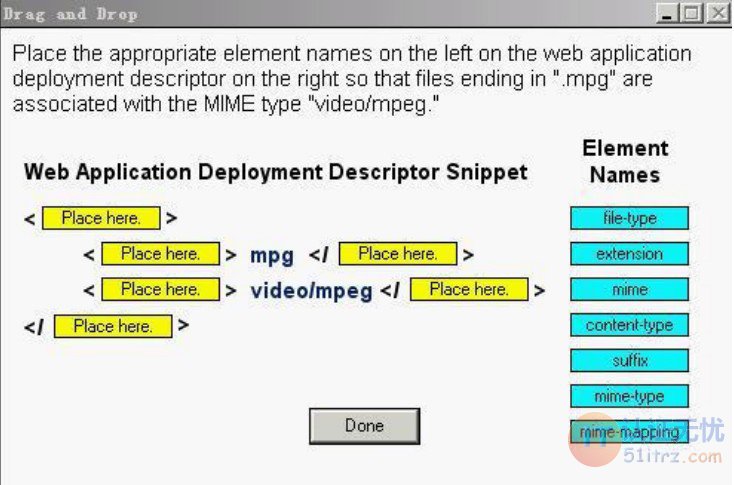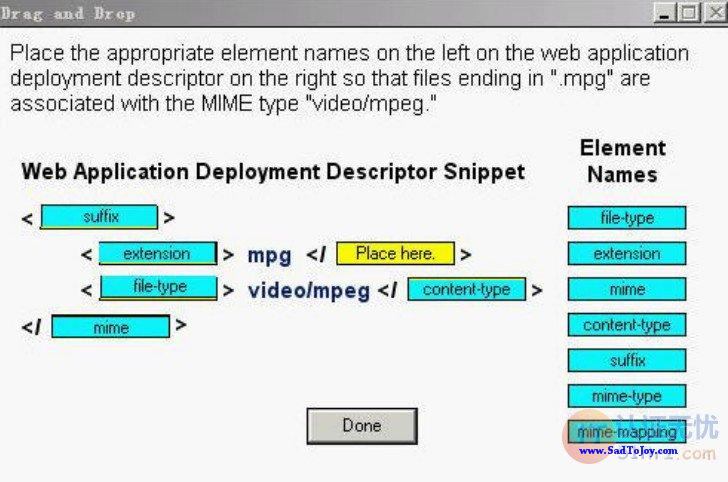Question: 41
Which three are valid URL mappings to a servlet in a web deployment descriptor? (Choose three.)
A. */*
B. *.do
C. MyServlet D. /MyServlet
E. /MyServlet/*
F. MyServlet/*.jsp
Answer: B, D, E
Question: 42
Click the Task button.
Place the appropriate element names on the left on the web application deployment descriptor on the right so that files ending in ".mpg" are associated with the MIME type "video/mpeg."

Answer:

Question: 43
Which three web application deployment descriptor elements allow web components to gain references to resources or EJB components? (Choose three.)
A. ejb-ref
B. jdbc-ref
C. servlet-ref
D. resource-ref
E. javamail-ref
F. ejb-remote-ref
G. resource-env-ref
Answer: A, D, G
Question: 44
After a merger with another small business, your company has inherited a legacy WAR file but the original source files were lost. After reading the documentation of that web application, you discover that the WAR file contains a useful tag library that you want to reuse in your own webapp packaged as a WAR file. What do you need to do to reuse this tag library?
A. Simply rename the legacy WAR file as a JAR file and place it in your webapp's librarydirectory.
B. Unpack the legacy WAR file, move the TLD file to the META-INF directory, repackage the whole thing as a JAR file, and place that JAR file in your webapp's library directory.
C. Unpack the legacy WAR file, move the TLD file to the META-INF directory, move the class files to the top-level directory, repackage the whole thing as a JAR file, and place that JAR file in your webapp's library directory.
D. Unpack the legacy WAR file, move the TLD file to the META-INF directory, move the class files to the top-level directory, repackage the WAR, and place that WAR file in your webapp's WEB-INF directory.
Answer: C
Question: 45
Which two actions protect a resource file from direct HTTP access within a web application? (Choose two.)
A. Placing it in the /secure directory
B. Placing it in the /WEB-INF directory
C. Placing it in the /META-INF/secure directory
D. Creating a <web-resource> element within the deployment descriptor
E. Creating a <secure-resource> element within the deployment descriptor
Answer: B, C
Question: 46
Given that www.example.com/SCWCDtestApp is a validly deployed Java EE web application and that all of the JSP files specified in the requests below exist in the locations specified. Which two requests, issued from a browser, will return an HTTP 404 error? (Choose two.)
A. http://www.example.com/SCWCDtestApp/test.jsp
B. http://www.example.com/SCWCDtestApp/WEB-INF/test.jsp
C. http://www.example.com/SCWCDtestApp/WEB-WAR/test.jsp
D. http://www.example.com/SCWCDtestApp/Customer/test.jsp
E. http://www.example.com/SCWCDtestApp/META-INF/test.jsp
F. http://www.example.com/SCWCDtestApp/Customer/Update/test.jsp
Answer: B, E
Question: 47
Which two about WAR files are true? (Choose two.)
A. WAR files must be located in the web application library directory.
B. WAR files must contain the web application deployment descriptor.
C. WAR files must be created by using archive tools designed specifically for that purpose.
D. The web container must serve the content of any META-INF directory located in a WAR file.
E. The web container must allow access to resources in JARs in the web application library directory.
Answer: B, E
Question: 48
Given this fragment from a Java EE deployment descriptor:
124. <welcome-file>beta.html</welcome-file>
125. <welcome-file>alpha.html</welcome-file>
And this request from a browser:
http://www.sun.com/SCWCDtestApp/register
Which statement is correct, when the container receives this request?
A. This deployment descriptor is NOT valid.
B. The container first looks in the register directory for beta.html.
C. The container first looks in the register directory for alpha.html.
D. The container first looks for a servlet mapping in the deployment descriptor.
Answer: D
Question: 49
Which EL expression evaluates to the request URI?
A. ${requestURI}
B. ${request.URI}
C. ${request.getURI}
D. ${request.requestURI}
E. ${requestScope.requestURI}
F. ${pageContext.request.requestURI}
G. ${requestScope.request.requestURI}
Answer: F
Question: 50
Given:
1. <% int[] nums = {42,420,4200};
2. request.setAttribute("foo", nums); %>
3. ${5 + 3 lt 6}
4. ${requestScope['foo'][0] ne 10 div 0}
5. ${10 div 0}
What is the result?
A. True true
B. False true
C. False true 0
D. True true Infinity
E. False true Infinity
F. An exception is thrown.
G. Compilation or translation fails.
Answer: E